

The unit setup can be found under Window -> Settings/Preferences -> Preferences: Import the created solid to your 3D scene and use it as a reference. Simply create a 1x1x1m designer object and go to Level menu -> Export Selected Objects and save the file type as either an *.obj or *.fbx file. There is also a very useful way to get the measurement feedback directly from the Engine. You can also adjust the grid and make it more readable while working on an asset. Good luck! Don’t forget that surpassing my result is very simple – just experiment more.The best way to work in Maya is to set the unit to centimeters. Making a render test by F9 at the active type of camera/perspective or pressing the Render button as shown on the picture 10ġ0 Add another thin Vray Light as on the picture 11 for more contrast thin reflections.ġ2 The same scene and material of paint on the car model. Create material of the studio – ordinary grey V-ray material (picture 8) and material of the auto paint (picture 9)ĩ. To make the background illuminated softly from beneath you would have to decrease Hotspot/Beam and increase Falloff/Field in Spotlight ParametersĨ. Target it from a sphere on a wall as shown on the picture 7. I achieved the best results with Target Spot. The most important effect of a studio is the illumination that goes beneath the background. This will help you designing your environments really fast having the final shot controlled as well as the overall scene structure. In future pressing P will allow you to switch to the Perspective View mode fast twisting the view and turning it and then going back to the fixed one simply pressing C. After the required foreshortening of the Perspective View is selected (along the diagonal through the studio having the sphere in the center of the view) press Ctrl+C to create a Camera and fix the chosen foreshortening. Well and for the tests of the auto paint create a sphere in the middle of the studio.ħ. Intensity (Multiplier of every source is to be picked up by the means of several experimental attempts)Ħ. And exactly this will give the effect of the dissipated light as in the real studio. All of the light sources are directed on walls.
3ds max studio setup how to#
You can see how to locate them correctly on the picture 5. We will create illumination with V-ray lights. And also use Mesh Smooth for smoothing the surfaces.ĥ. To create the same for ceiling apply Symmetry simply.

To create a smooth transition select edges along connection of the wall and the floor and apply Chamfer. After that operation you will have the floor with a direct corner in relation to walls. For this purpose select the lower edges of the wall, hold Shift and move a lower verge forward, and after Scale Down you will get new edges. After extruding convert the object to Editable Poly or apply Edit Poly modifier to make bottom of the wall fluently become a floor. Apply Extrude modifier to the newly created spline to model the wall. Then create a line (not necessarily NURBS, but my opinion is that nurbs is the quickest and high-quality mean to create beautiful bends what is actually needed to form the wall of the studio)Ĥ. Set parameters of V-ray and Indirect Illumination rollouts as shown on the following pictures:ģ. At the Common tab expand Assign Render rollout and show the dialog to select V-ray reder by pressing the button with the triple-dot.Ģ. Press F10 to show rendering settings dialog or the button with the tea-pot icon on the main panel as shown on the picture 1.


 0 kommentar(er)
0 kommentar(er)
